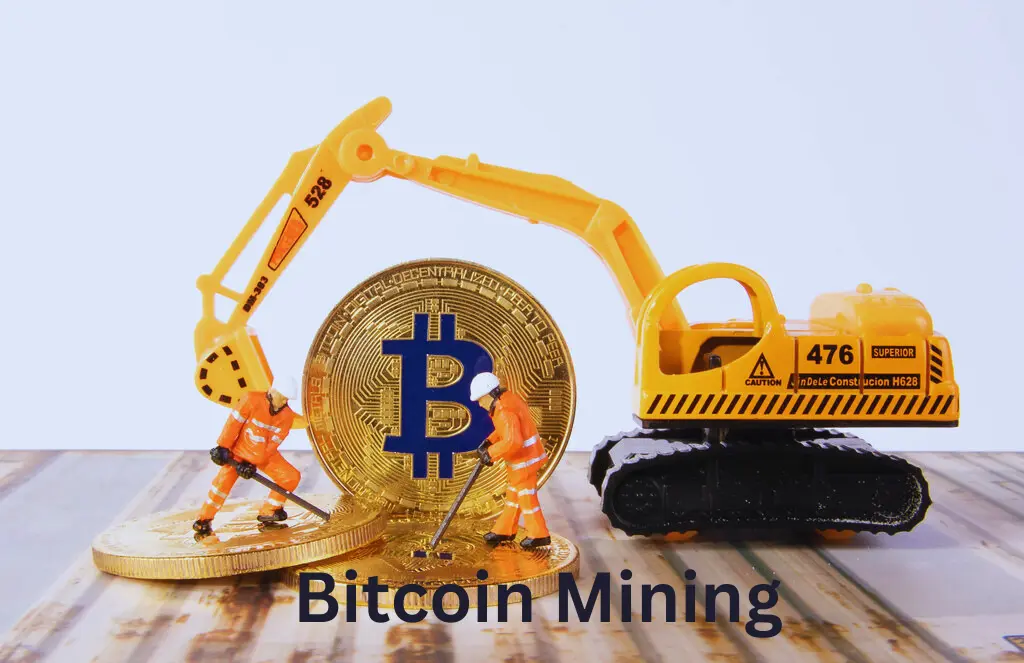Bitcoin Mining

Bitcoin mining is an essential aspect of the digital currency world, as it forms the backbone of the decentralized network that sustains the entire system. For those who may not be aware, mining refers to the process of validating and recording transactions on the blockchain, the public ledger that forms the foundation for cryptocurrencies like Bitcoin. Miners, who are typically the driving forces behind this activity, expend their computational resources to solve complex mathematical problems in order to add new blocks to the blockchain, thus earning rewards in the form of newly minted Bitcoins.
At its core, Bitcoin mining aims to promote trust, security, and decentralization in the digital currency ecosystem. The process is deliberately designed to be intensive and resource-consuming, as the complexity of mining tasks ensures that only dedicated and committed parties participate. These participants, in turn, contribute to the overall strength and stability of the Bitcoin network by preventing any one individual or entity from wielding too much control over the system.
As Bitcoin mining evolves and becomes increasingly competitive, the industry has witnessed remarkable advancements in hardware technologies and mining strategies. Today’s miners employ specialized, high-performance equipment known as ASICs (Application-Specific Integrated Circuits) to optimize their mining efficiency and profitability. Consequently, the landscape of Bitcoin mining is in a constant state of flux as individuals and organizations jostle to secure a foothold in this digital gold rush.
The Basics of Bitcoin Mining
What Is Bitcoin Mining?

Bitcoin mining is the process of verifying and adding new transactions to the decentralized Bitcoin blockchain. Miners use powerful computer hardware to solve complex mathematical puzzles. Once a puzzle is solved, they can add a new “block” to the chain. In return for their efforts, miners receive newly minted bitcoins as a reward.
Purpose and Functionality
The primary purpose of Bitcoin mining is to:
- Validate and confirm transactions, ensuring they are legitimate and preventing double-spending.
- Maintain the decentralized, trustless nature of the Bitcoin network.
- Distribute new bitcoins into circulation, following a predefined schedule.
These functions help to maintain a secure, transparent, and decentralized financial system, where no central authority can control the issuance of new bitcoins or manipulate transaction records.
Proof of Work Concept
The backbone of Bitcoin mining is the Proof of Work (PoW) concept. PoW requires miners to demonstrate that they have expended their computational resources (electricity and processing power) to solve the puzzle for each new block.
The main characteristics of PoW are:
- Computationally Difficult: Miners must perform complex calculations to find the solution to each block’s puzzle.
- Easily Verifiable: Other nodes on the network can quickly check if the solution is valid.
- Adaptive Difficulty: The difficulty of the puzzles adjusts according to the network’s hash rate, maintaining a consistent block time of ~10 minutes.
The PoW algorithm ensures that competition among miners remains fair and the network remains secure from external attacks. It is through this process that Bitcoin mining creates a self-regulating, decentralized ecosystem.
Bitcoin Mining Hardware
ASIC Miners
Application-Specific Integrated Circuit (ASIC) miners are the most efficient hardware for Bitcoin mining. They are specifically designed for mining cryptocurrencies based on the SHA-256 algorithm, such as Bitcoin. Here are some popular ASIC miner models:
- Bitmain Antminer S19: 95 TH/s, 3250W
- MicroBT Whatsminer M30S: 88 TH/s, 3268W
- Canaan AvalonMiner 1246: 90 TH/s, 3420W
The efficiency of an ASIC miner is typically determined by its hash rate (TH/s) and power consumption (W). Higher hash rates and lower power consumption mean better mining efficiency.
GPU and CPU Mining
Before ASIC miners, Graphics Processing Units (GPUs) and Central Processing Units (CPUs) were used for Bitcoin mining. However, compared to ASICs, these hardware types are less efficient and generate lower hash rates. A GPU miner might reach a hash rate of 30-40 MH/s, which is significantly lower than an ASIC miner.
For CPUs, mining efficiency is worse than for GPUs. CPU mining is generally not profitable due to its low hash rate and high power consumption.
Mining Rigs and Their Components
A mining rig is a combination of hardware components specifically assembled for cryptocurrency mining. A typical mining rig contains:
- Mining Hardware: ASIC miners for Bitcoin mining or GPU miners for other algorithms.
- Motherboard: For connecting and managing multiple mining devices.
- Power Supply Unit (PSU): Provides sufficient power to run the mining hardware.
- RAM: At least 4-8 GB is recommended for smooth operation.
- Storage: A hard drive or solid-state drive is needed for storing the mining software and blockchain data.
- Cooling System: Fans or liquid cooling systems are crucial to dissipate excess heat generated by mining hardware.
- Internet Connection: A stable and fast internet connection is necessary to submit mined blocks and stay synchronized with the network.
Although some users prefer GPU mining for its flexibility and lower initial cost, ASIC mining is considered more profitable due to its superior efficiency. Nowadays, ASIC miners are the dominant hardware choice for Bitcoin mining.
Bitcoin Mining Software
Choosing Mining Software
When selecting Bitcoin mining software, it is essential to consider its compatibility with your mining hardware and the operating system you are using. In addition, look for the following features:
- User-friendly interface: Allows you to easily monitor and control your mining activities.
- Performance: Optimal hash rate maximizes your revenue potential.
- Customizability: Offers the ability to fine-tune settings for advanced users.
- Updates: Frequent updates to ensure the latest security patches and mining algorithm enhancements.
Mining Pools vs. Solo Mining
Mining pools are groups of miners who come together to combine their computational power to increase the chances of mining a block. The rewards are then distributed among participants based on their contributed hash rates. Some advantages of mining pools include:
- Increased probability of finding blocks and receiving rewards
- Steady income, even if the individual miner’s power is relatively low
- Lower variance in earnings compared to solo mining
However, solo mining allows you to keep the entire mining reward and directly contribute to the blockchain’s security. But it could take years before you successfully mine a block, making solo mining suitable for miners with considerable computing power.
Popular Software Options
There are several popular and reliable Bitcoin mining software options available:
- CGMiner: A popular, open-source, multi-platform miner that supports various mining algorithms. Offers advanced features such as fan speed control, remote monitoring capability, and overclocking.
- BFGMiner: Similar to CGMiner, BFGMiner supports a wide range of mining hardware and provides customizable features for advanced users. It also emphasizes enhanced efficiency and stability.
- EasyMiner: A user-friendly, graphical interface Bitcoin mining software that is compatible with CGMiner and BFGMiner. EasyMiner is ideal for beginners or those seeking a straightforward experience.
| Software | Platform | User Interface | Features |
|---|---|---|---|
| CGMiner | Multi-OS | Command Line | Advanced customizability options |
| BFGMiner | Multi-OS | Command Line | Emphasis on efficiency & stability |
| EasyMiner | Windows | Graphical | User-friendly & straightforward |
Remember to research and choose the mining software that best meets your needs and hardware capabilities, and always prioritize security and reliability in your selection.
Miner Network and Incentives
The Role of Nodes
In the Bitcoin network, nodes play a crucial role in maintaining the decentralized nature of the system. They are responsible for validating transactions and mining new Bitcoins. There are two types of nodes: full nodes and mining nodes. Full nodes store the entire blockchain, while mining nodes focus on solving complex mathematical problems to mine new blocks.
- Full nodes: These nodes download, store, and validate every transaction on the blockchain. They ensure the network operates in a trustless manner.
- Mining nodes: These nodes (also called miners) participate in the Proof-of-Work (PoW) process, investing computational power to mine new blocks and secure the network.
Mining Rewards

Miners earn rewards for their efforts in securing the network and validating transactions. The reward consists of two parts: a block reward and transaction fees.
- Block reward: The block reward is released when a miner successfully mines a new block and is added to the blockchain. This reward consists of newly minted Bitcoins and currently stands at 6.25 BTC per block. The block reward is halved approximately every four years (or 210,000 blocks) in a process called the halving. The halving ensures that only 21 million Bitcoins will ever be mined.
- Transaction fees: In addition to the block reward, miners also earn transaction fees from every transaction included in a mined block. These fees incentivize miners to continue mining and securing the network as the block reward decreases over time.
Transaction Fees
To be included in a block, every Bitcoin transaction must include a mandatory transaction fee paid by the sender. This fee is used to prioritize transactions in the memory pool (mempool) — a collection of unconfirmed transactions waiting to be included in a block.
The transaction fees are determined by the market demand for block space on the blockchain. As the demand for transaction confirmations grows, senders must compete by offering higher fees to incentivize miners to prioritize their transactions. In this way, the transaction fees help regulate the network’s usage and ensure a timely confirmation of transactions.
Energy Consumption and Sustainability
Electricity Costs
Bitcoin mining is an energy-intensive process as miners require massive amounts of electricity to solve complex computational problems. The average electricity consumption per Bitcoin transaction has been estimated to be approximately 1,033 kWh, which is enough to power an average US household for over a month. Countries with cheaper electricity, such as China, Russia, and Kazakhstan, have become major hubs for mining operations.
A comparison of electricity costs per kWh in USD for different countries is shown in the table below:
| Country | Electricity Cost (USD/kWh) |
|---|---|
| China | 0.08 |
| Russia | 0.09 |
| Kazakhstan | 0.05 |
| United States | 0.12 |
| Germany | 0.30 |
Renewable Energy and Mining
The immense energy consumption of Bitcoin mining has led to increasing concerns about its environmental impact. As a result, some mining companies have begun to adopt more sustainable methods by transitioning to renewable energy sources. Iceland, for instance, is a popular destination for miners due to its abundant geothermal and hydroelectric power. Reports suggest that 74% of Bitcoin mining worldwide is now powered by renewable energy.
Some mining companies have also implemented creative solutions to reduce energy consumption. For example, miners in colder regions may use heat generated from mining equipment to help heat buildings during winter.
Energy Consumption Controversies
Despite efforts to adopt renewable energy and improve sustainability, Bitcoin mining still faces criticism for its energy consumption. Opponents argue that the amount of electricity used could be better allocated to more important societal needs. They also claim that the reliance on non-renewable energy contributes to climate change and exacerbates existing environmental problems.
On the other hand, supporters of Bitcoin mining argue that the benefits of decentralized currency and the potential for financial innovation outweigh the environmental concerns. They emphasize the increasing use of renewable energy sources and the active pursuit of sustainable solutions within the industry.
Mining Difficulty and Hash Rate
Difficulty Adjustment
The mining difficulty in the Bitcoin network is a crucial factor that adjusts every 2016 blocks (approximately every two weeks). This adjustment ensures that new blocks are mined at a reasonably consistent rate and maintains the desired 10-minute block time. The difficulty adjusts depending on the total computational power, or hash rate, dedicated to mining Bitcoin.
When more miners join the network, the difficulty increases to account for the additional hash power. Conversely, when miners leave the network, the difficulty decreases to rebalance and maintain the 10-minute block time.
Calculating Hash Rate
The hash rate refers to the speed at which a miner is performing calculations to find a valid block and is measured in hashes per second (H/s). A higher hash rate signifies stronger computational power. Hash rate can be measured in different scales, such as:
- Kilohashes per second (KH/s)
- Megahashes per second (MH/s)
- Gigahashes per second (GH/s)
- Terahashes per second (TH/s)
- Petahashes per second (PH/s)
Here’s a simple reference table for these units:
| Unit | Hashes per Second |
|---|---|
| 1 KH/s | 1,000 H/s |
| 1 MH/s | 1,000,000 H/s |
| 1 GH/s | 1,000,000,000 H/s |
| 1 TH/s | 1,000,000,000,000 H/s |
| 1 PH/s | 1,000,000,000,000,000 H/s |
To calculate a miner’s hash rate, one can use specialized software or websites that provide this function. It’s important to note that a miner’s hash rate may vary, as it depends on factors such as power usage, cooling, and hardware efficiency.
Impact on Mining Profitability
Mining profitability is highly influenced by the interplay of mining difficulty and hash rate. As the difficulty increases, a miner’s chances of mining a block decrease, leading to potentially lower rewards. A higher hash rate helps to counterbalance the increased difficulty, allowing the miner to maintain a competitive edge in the network.
However, a high hash rate comes with its own challenges, such as increased power consumption and potential hardware wear-and-tear. These factors may impact profitability, and miners must continually evaluate their operations to optimize costs and maximize potential rewards.
Bitcoin Mining Security

51% Attack Explained
A 51% attack occurs when a malicious miner or group of miners control more than 50% of the network’s mining hashrate. This manipulation allows them to do the following:
- Double-spending: The attacker can spend the same coins more than once by creating conflicting transactions.
- Censorship: They may selectively prevent transactions from being included in newly mined blocks.
- Chain reorganization: The attacker can rewrite parts of the chain, undoing previous transactions.
However, executing a 51% attack is prohibitively expensive, as it requires massive amounts of computational power. Additionally, the attack’s visibility would likely cause a loss of trust in the currency, diminishing the attacker’s potential gains.
Mining and Network Security
Bitcoin mining contributes to network security in several ways:
- Proof-of-work (PoW): Miners solve complex mathematical problems, adding new blocks to the blockchain and validating transactions. PoW makes it challenging and expensive for malicious actors to gain control of the network.
- Decentralization: A decentralized network of miners around the globe reduces the concentration of power, making it unlikely for any one entity to take control.
- Consensus mechanism: Conflicting transactions and blocks are resolved through a consensus mechanism in the network, which ensures that only valid transactions are included in the blockchain.
To maintain security, miners must constantly update their hardware and software, following the best practices outlined below.
Best Practices for Miners
Miners can take several steps to secure their operations and contribute to the overall network security:
- Use high-quality hardware: Investing in reliable mining equipment reduces the risk of hardware failure, leading to more consistent mining performance.
- Keep software updated: Install regular updates for mining software and security patches to protect against vulnerabilities.
- Monitor mining operations: Regularly check network connections, hashrate, and mining performance to detect potential issues early.
- Join reputable mining pools: Participating in a well-established mining pool can help reduce variance in mining rewards and promote cooperative network security measures.
- Implement secure storage: Use hardware wallets or cold storage solutions to protect mined cryptocurrencies from potential theft or loss.
Legal and Regulatory Aspects
Mining Regulations Worldwide
Since the inception of Bitcoin, mining regulations worldwide have been a topic of continuous change. Governments are trying to keep up with the rapid developments and to strike a balance between protecting consumers and fostering innovation. In some countries, like China and India, cryptocurrency mining has faced regular crackdowns and stringent regulations. This is due to concerns about environmental impacts, energy consumption, and financial stability.
On the other hand, there are countries that have welcomed the industry with open arms and favorable legislation. Examples include Canada, Iceland, and Sweden, which boast relatively low energy costs and cool climates to keep the mining rigs cool. Additionally, Switzerland and Malta have introduced progressive regulatory frameworks to make it possible for innovative crypto-businesses to thrive.
Taxation and Reporting
When it comes to taxation and reporting, different countries have distinct legislation and classification of cryptocurrencies:
- United States: The Internal Revenue Service (IRS) has classified cryptocurrencies as property for tax purposes. As a result, miners are obligated to file a Schedule 1 form with their federal income tax return and are subject to self-employment tax in cases of mining activity as a business endeavor.
- United Kingdom: HM Revenue and Customs (HMRC) treats cryptocurrencies similarly to other investments. If mining is conducted as a hobby, no tax is due on the mining income, but capital gains tax may apply when disposing of the mined coins.
- European Union: The European Central Bank (ECB) does not have fully harmonized tax rules for cryptocurrency mining across its member states. Consequently, tax treatment varies significantly among the EU countries. Miners must pay close attention to local tax laws and obligations.
Legal Challenges for Miners
Miners worldwide often face legal challenges, including:
- Lack of clarity in regulations: As governments struggle to keep up with the evolving crypto landscape, regulations remain unclear and outdated in some jurisdictions.
- Changing policy landscapes: Unstable policies and abrupt changes in regulations can lead to uncertain market conditions and increased operational risks.
- Energy consumption: It is widely known that mining requires significant power consumption, resulting in environmental concerns and prompting certain regions to impose strict energy consumption policies.
- Restrictions on use: Some jurisdictions, like India and Bangladesh, have restricted or even banned the use of cryptocurrencies. Mined coins may not be legally traded, affecting the overall profitability of mining operations.
In conclusion, the legal and regulatory aspects of Bitcoin mining are ever-evolving and vary greatly by jurisdiction. Miners should be aware of the rules and restrictions in their areas of operation to avoid running afoul of the law and ensure the long-term success of their mining ventures.
Bitcoin Mining Trends
Technological Advancements
In recent years, significant technological advancements have occurred in the field of Bitcoin mining. The mining hardware has evolved from simple CPUs to high-performance GPUs, and now to ASICs (Application-Specific Integrated Circuits). These specialized devices are specifically designed to perform Bitcoin mining tasks with greater efficiency.
Another critical development is the emergence of mining pools, which allow miners to pool their resources and share the rewards proportional to their contributed computational power. This has led to the increasing popularity of cloud mining services, allowing smaller participants to mine Bitcoin without investing in expensive hardware.
An essential advancement to note is the shift towards sustainable energy sources within the Bitcoin mining industry. Solar power, wind energy, and hydropower have become more prevalent, reducing the industry’s carbon footprint and overall energy costs.
Decentralization Efforts
Since the inception of Bitcoin, a major concern has been the centralization of mining power within a few large-scale operations. Multiple efforts seek to address this imbalance:
- Stratum V2 protocol: This protocol aims to make Bitcoin mining more accessible by improving security and reducing bandwidth requirements, thus lowering the barrier to entry for miners.
- Geographical distribution: With globally distributed mining pools, mining power is gradually being spread across different regions, contributing to the decentralization of the Bitcoin network.
- Community-driven initiatives: Some projects promote mining decentralization by advocating for home-based mining and developing mining solutions that cater to small-scale miners.
Future of Bitcoin Mining
The sustainability of Bitcoin mining remains a relevant topic of discussion, given the increasing difficulty level of mining and the electrical power required. The utilization of renewable energy sources is expected to increase as the sector moves towards eco-friendly operations.
Another significant trend is the emergence of liquid immersion cooling systems, designed to decrease the operating temperature of mining hardware. This technology can potentially improve mining efficiency and extend the life of mining equipment.
The Bitcoin mining industry will also need to respond to the growth of layer two solutions, such as Lightning Network and other second-layer protocols. These technologies aim to reduce transaction fees and congestion on the Bitcoin blockchain, possibly decreasing the demand for resource-intensive mining in the future.
Frequently Asked Questions
Q1- What are the system requirements for cryptocurrency mining software on Windows?
Answer: The system requirements for cryptocurrency mining software on Windows depend on the specific software being used and the type of mining hardware. Generally, mining software should run on a Windows 7 or newer operating system with a 64-bit CPU, at least 4 GB of RAM, and an up-to-date graphics card driver. More advanced mining setups may require more processing power, RAM, and specialized mining hardware like ASICs or GPUs.
Q2- How does one choose the best Bitcoin mining stocks to invest in?
Answer: Choosing the best Bitcoin mining stocks involves analyzing several factors, including the company’s market position, financial stability, growth potential, and management team. Investors should research the mining company’s history, and financial records, and compare the stock’s performance with industry benchmarks and competitors. It’s also important to consider external factors such as regulations and market demand for Bitcoin.
Q3- Which Bitcoin mining apps are most effective for beginners?
Answer: For beginners, easy-to-use and popular Bitcoin mining apps such as Honeyminer, NiceHash, and Cudo Miner are recommended. These mining apps provide user-friendly interfaces and support multiple cryptocurrencies, enabling beginners to start mining without advanced technical knowledge. However, users should always perform due diligence and independently assess the efficiency and legitimacy of any mining software before using it.
Q4- What is the expected ROI for Bitcoin mining using consumer-grade hardware?
Answer: The expected return on investment (ROI) for Bitcoin mining using consumer-grade hardware largely depends on factors such as Bitcoin’s price, mining hardware efficiency, electricity costs, and network mining difficulty. Generally, mining with consumer-grade hardware may not be profitable due to high electricity costs and competition from specialized mining equipment. To assess potential ROI, users can use online mining calculators and input their specific mining conditions and expenses.
Q5- Is it possible to mine Bitcoin profitably without significant investment?
Answer: Mining Bitcoin profitably without a significant investment is challenging due to the high level of competition and specialized mining equipment dominating the industry. However, some options for low-cost mining include joining a mining pool, taking advantage of free or low-cost electricity, and utilizing affordable and energy-efficient mining hardware. Profit margins may still be thin, and there is always the risk of not recouping the initial costs.
Q6- What are the legal considerations for Bitcoin mining in different countries?
Answer: The legal status of Bitcoin mining varies across different countries. Some countries, such as the United States, Canada, and most European countries, allow mining but may have specific regulations regarding tax, power consumption, and other issues. In contrast, other countries like China have implemented stricter measures to control cryptocurrency mining. Before beginning mining operations, miners should familiarize themselves with local laws and regulations to ensure compliance.






